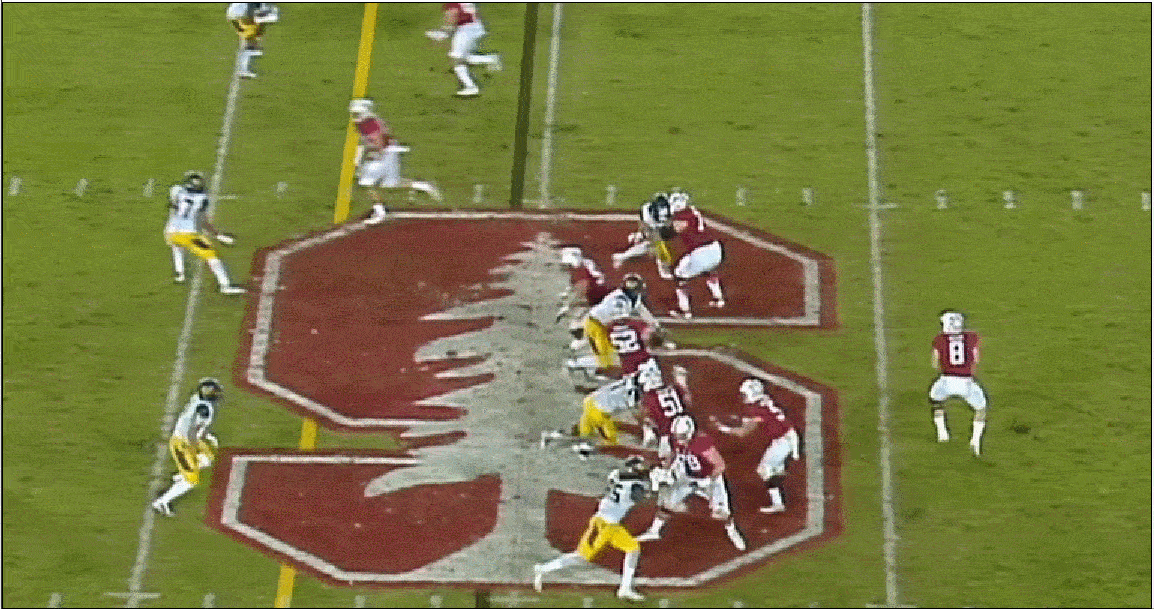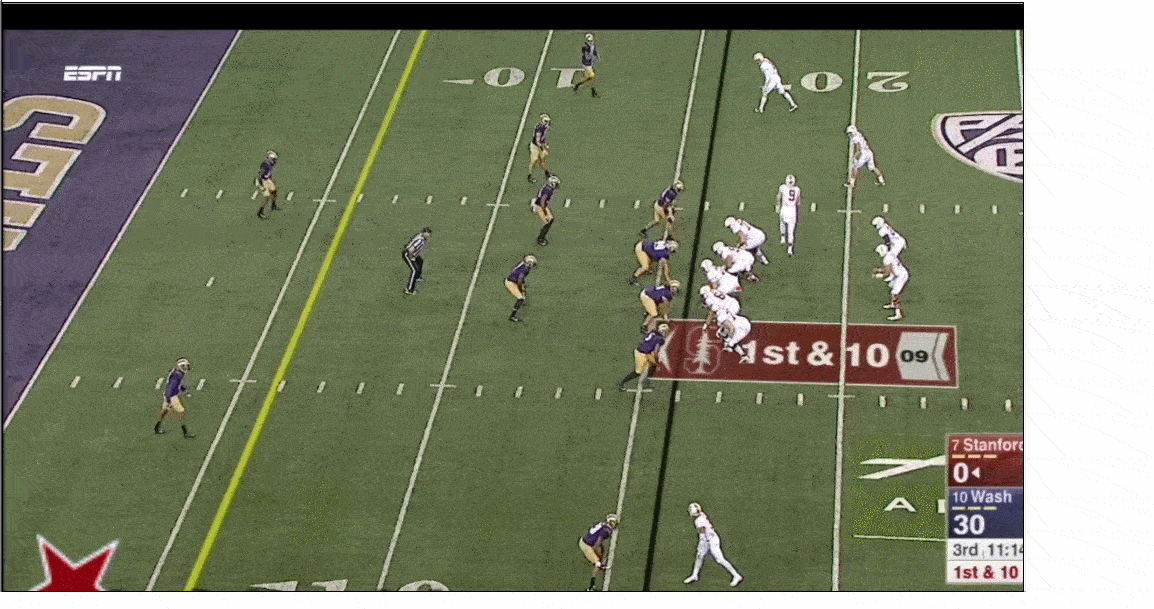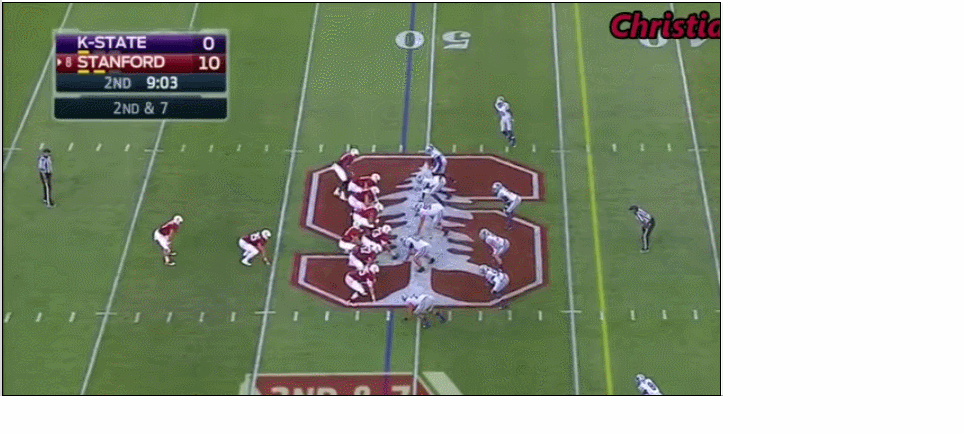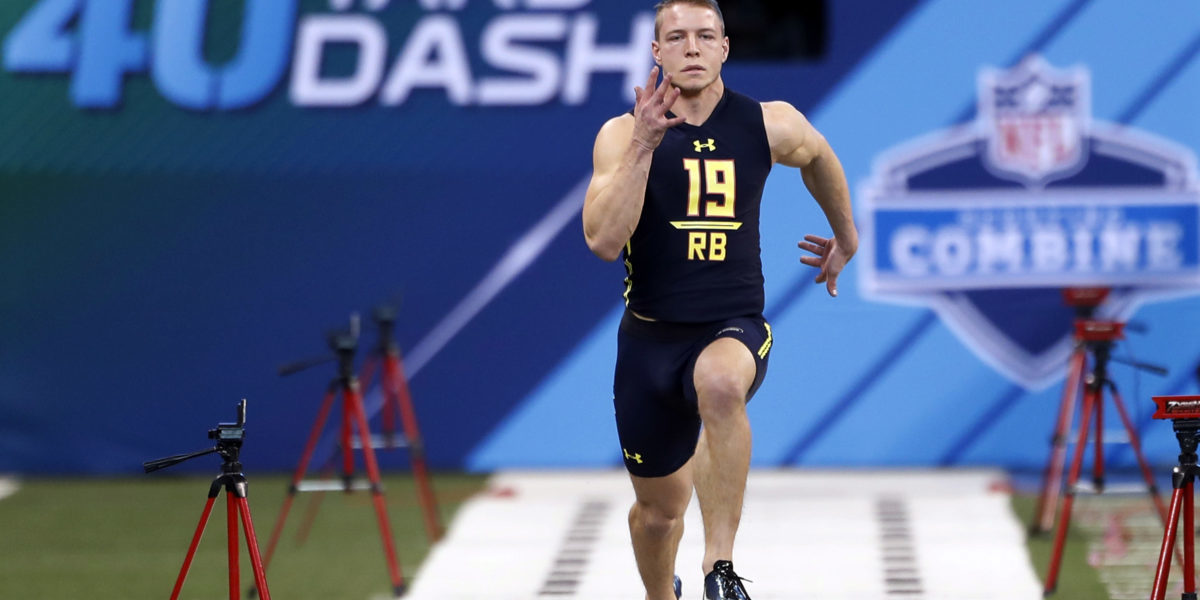In this series, I will be previewing a few of the draft picks and how I believe they can contribute in their rookie year. Fittingly, Panthers first round pick Christian McCaffrey from Stanford is first on our list. The Heisman runner up in 2015 stands at 5-feet 11-inches and just over 200 pounds, and while he does not fit the “hog molly” archetype that General Manager Dave Gettleman loves to bring in through the draft, his speed and versatility add a dimension the Panthers have not had in their backfield since a certain injury-prone Michigan RB with a lot of letters in his last name.
Scheme Versatility
In the introduction, I did not say that McCaffrey played running back at Stanford. That is because in reality he is an “offensive weapon” (OW); generally I apply this moniker to players who are superior athletes and can contribute anywhere on the field: Percy Harvin, David Johnson, Le’Veon Bell, and Braxton Miller are examples of the current NFL players who fall into the OW category. Basically, McCaffrey can line up at any skill position on the offense and make an impact; don’t be surprised to even see a Wildcat formation in 2017 with McCaffrey at quarterback, new addition Curtis Samuel at running back and Cam Newton at wide receiver. Falcons Defensive Coordinator Marquand Manuel is quaking in his boots at the thought. Coach Rivera on his shiny new weapon:
“Well it’s going to be about position flexibility more so than anything else. He’s going to be used a lot in a way of how they used him at Stanford. When you watch the tape, break the tape down, you see him line up sometimes in the backfield as a running back. Sometimes he’s a quarterback in their wildcat offense. Sometimes they motion him out and put him out to the slot. Sometimes they motion him out and put him wide. So we’re looking at opportunities to create opportunities for him to make plays for us…”
Passing Game Impact
One place the Panthers really struggled during the 2016 season was in the passing game. Screens were rarely used, play action passes often devolved into foot races the Panthers couldn’t win, and the only players who could consistently find separation were Greg Olsen and Ted Ginn. McCaffrey offers the Panthers a unique offensive piece that can heavily impact the short-to-medium-range passing game. On play-action he will need to be accounted for first as a rusher, and then as a receiving option. The Cardinal offense used him on a number of play fake and bump-and-run type plays that forced defenses to double him up or pay the price for leaving McCaffrey on an island in space. He can also split out as a wide receiver on third downs and be a real receiving threat or be put in motion to force the defense to show their hand before the snap which in turn makes it easier for offensive line adjustments, which in turn leads to more time for the quarterback, which in turn leads to more first downs, which in turn leads to more touchdowns.
McCaffrey in Motion = More Touchdowns.
The GIF below is a great example of how he can be used on third downs. On Stanford’s first drive of the game he is split out wide at the top of your screen. McCaffrey runs a comeback route that goes for six yards and a first down. As the play develops, he realizes his route runs into the zone of a linebacker without another option and immediately cuts to the outside where he is in a soft spot directly in front of the first down marker. Jerricho Cotchery was a player who brought this intelligence and precision to route running in the Panthers offense in 2015, but was sorely missed it in 2016.

The biggest impact he will have in the passing game will be on screens and swing passes. During the 2016 season, the Panthers did not have a player who could be a reliable option for screens with Benjamin and Funchess being too big, Ginn being too much of a straight line runner and Jonathan Stewart not having reliable hands. McCaffrey made some huge plays on screens at Stanford but more importantly he was a reliable option they could go to and know that he wouldn’t drop the pass, or worse, lose yardage.
Screen plays rely on deception to trap the defense in an unfavorable position. While Stanford disguised their screens well, sporadically their opponents would sniff them out quickly; on these occasions, because of McCaffrey’s rare blend of vision and agility it didn’t matter, if the OW had even an inch of space he found at least five yards. Here are two plays that showcase his ability to gain yardage on screens regardless of how well the defense plays. The first came midway through the second quarter against Stanford’s biggest rival, California. The Cardinal called a screen pass while the Bears only rush four players. The defense keys in on the play quickly, but McCaffrey’s quick feet and instincts were on full display on this play, as he has enough room to catch the ball, turn, and accelerate to the end zone even though his blockers are outmatched and the defenders have him dead to rights in the backfield.

The second play is more of a swing pass, and comes early in the third quarter against the Washington Huskies, a top 20 NCAA defense in 2016. With the Cardinal in the red zone, McCaffrey is lined up in the slot and the Huskies are playing zone coverage. Stanford calls a wide receiver screen/swing pass hybrid to McCaffrey that goes for five yards, even though the defense plays the play perfectly, with a defender blocking the sideline and two occupying the middle against two blockers. McCaffrey’s acceleration and change of direction made this play a positive gain instead of a drop for a loss. These kind of plays must be in the Panthers playbook for McCaffrey to be successful.

Running Game Impact
While he will certainly have an impact on the offense, McCaffrey was a luxury pick, similar to Shaq Thompson in 2015. Both were drafted to eventually replace veterans who are talented but aging. In Thompson’s rookie year he didn’t see many snaps thanks to the Panthers deploying more nickel packages than three linebacker sets but when he was on the field he made an impact which led to a slow increase in snaps as the season went on. Similarly I believe that McCaffrey will see few snaps to start the season, mainly as a change of pace back, but as the season continues he will split snaps with Jonathan Stewart more evenly and make a bigger impact on games.
McCaffrey’s biggest impact as a rusher will come on sweeps, outside zone plays and plays that utilize pulling guards. He has phenomenal vision and agility which are best highlighted when he is running behind a zone blocking scheme that gets him into space. If he ends up one-on-one with a defender in any situation, be it on a route or on a rushing play, that is a matchup he will win.

Christian McCaffrey will likely be a bigger impact in the passing game than the running game in his rookie year. He provides a skill set that the Panthers simply didn’t have in 2016 with his combination of suddenness, precision and hands. In the run game, the rookie’s contributions will likely be limited while Jonathan Stewart stays healthy and continues to play at a high level. McCaffrey may start the season as a low impact player in both dimensions of the offense and see his role (and subsequently his impact) grow as the season continues, he adjusts to the NFL, and the team learn how to best utilize him. Don’t go freaking out if he doesn’t have 200 total yards and twelve touchdowns in San Francisco. That will come later.



If as good as advertised I see McCaffrey playing early and often. Stewart will be utilized as a blocking back and backup to extend his career.